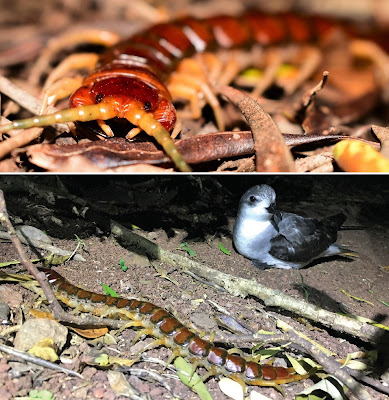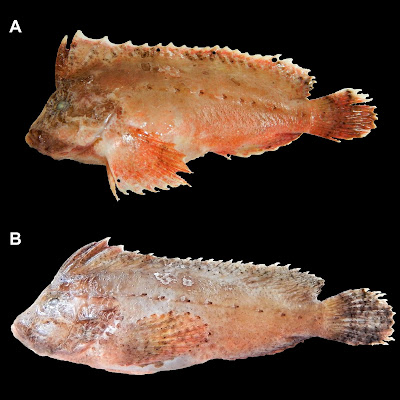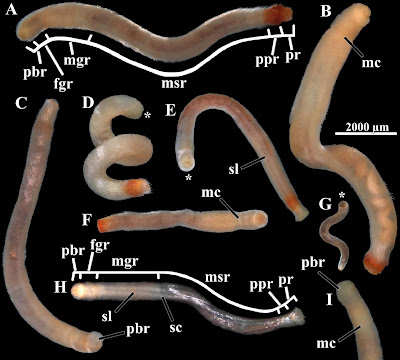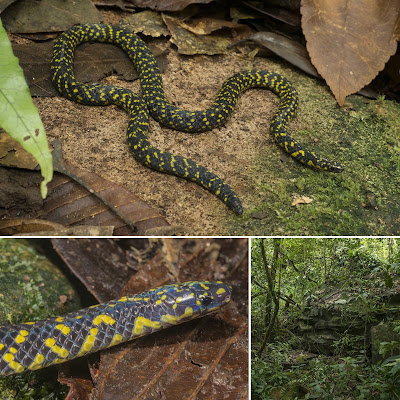[Most Recent Entries] [Calendar View]
Tuesday, August 17th, 2021
| Time | Event | ||||||||||||
| 4:29a | [Chilopoda / Ecology • 2021] Arthropod Predation of Vertebrates Structures Trophic Dynamics in Island Ecosystems
Abstract On isolated islands, large arthropods can play an important functional role in ecosystem dynamics. On the Norfolk Islands group, South Pacific, we monitored the diet and foraging activity of an endemic chilopod, the Phillip Island centipede (Cormocephalus coynei), and used a stable isotope mixing model to estimate dietary proportions. Phillip Island centipede diet is represented by vertebrate animals (48%) and invertebrates (52%), with 30.5% consisting of squamates, including the Lord Howe Island skink (Oligosoma lichenigera) and Günther’s island gecko (Christinus guentheri); 7.9% consisting of black-winged petrel (Pterodroma nigripennis) nestlings; and 9.6% consisting of marine fishes scavenged from regurgitated seabird meals. Centipede predation was the principal source of petrel nestling mortality, with annual rates of predation varying between 11.1% and 19.6% of nestlings. This means that 2,109–3,724 black-winged petrel nestlings may be predated by centipedes annually. Petrels produce a single offspring per year; therefore, predation of nestlings by centipedes represents total breeding failure for a pair in a given year. Our work demonstrates that arthropods can play a leading role in influencing vertebrate reproductive output and modifying trophic structures and nutrient flow in island ecosystems.
Luke R. Halpin, Daniel I. Terrington, Holly P. Jones, Rowan Mott, Wei Wen Wong, David C. Dow, Nicholas Carlile, and Rohan H. Clarke. 2021. Arthropod Predation of Vertebrates Structures Trophic Dynamics in Island Ecosystems. The American Naturalist. DOI: 10.1086/715702 La depredación de artrópodos sobre vertebrados estructura las dinámicas tróficas de ecosistemas insulares En islas remotas, los artrópodos de gran tamaño pueden jugar un papel funcional importante en la dinámica del ecosistema. En las Islas Norfolk, en el Pacífico sur, monitoreamos la dieta y comportamiento de forrajeo de un quilópodo endémico, el ciempiés de Phillip Island (Cormocephalus coynei), y usamos isótopos estables para estimar la composición de su dieta. La dieta del ciempiés de Phillip Island está representada por animales vertebrados (48%), e invertebrados (52%): con un 30.5%, las especies del orden Squamata como el eslizón de Lord Howe Island (Oligosoma lichenigera) o el gecko de Günther’s Island (Christinus guentheri); un 7.9% pollos de petrel alinegro (Pterodroma nigripennis); y un 9.6% peces obtenidos de los regurgitados de las aves marinas. La depredación por parte de los ciempiés fue la principal causa de mortalidad de los pollos de aves marinas, con tasas de depredación entre el 11.1% y el 19.6%. Considerando el límite superior del tamaño poblacional estimado para el petrel alinegro, los ciempiés podrían estar depredando 2.109–3.724 pollos por año en este ecosistema. Como los petreles producen un solo huevo por año, la depredación del pollo representa el fracaso reproductivo total para una pareja en ese año. Nuestra investigación demuestra que los artrópodos pueden desempeñar un papel central en los ecosistemas insulares, al influir en el éxito reproductivo de vertebrados y modificar las estructuras tróficas y el flujo de nutrientes. Giant bird-eating centipedes exist—and they're surprisingly important for their ecosystem | ||||||||||||
| 4:42a | [Ichthyology • 2021] Notes on the Poorly Known Velvetfish Cocotropus roseus (Scorpaeniformes: Aploactinidae) from the Eastern Indian Ocean
Abstract The present study provides notes on Cocotropus roseus Day, 1875, a poorly known endemic fish from the Bay of Bengal, Eastern Indian Ocean. The morphometric data and color images are provided herein based on fresh specimens collected from Chennai, south India, its type locality, Bay of Bengal, Eastern Indian Ocean. Keywords: Velvetfishes, Bycatch, Taxonomy, Chennai
Family Aploactinidae Jordan & Starks, 1904 Cocotropus Kaup, 1858. Cocotropus roseus Day, 1875 Paramasivam Kodeeswaran, Jayasimhan Praveenraj, Ronald Fricke, Arumugam Uma and Natarajan Jayakumar. 2021. Notes on the Poorly Known Velvetfish Cocotropus roseus (Scorpaeniformes: Aploactinidae) from the Eastern Indian Ocean. Thalassas: An International Journal of Marine Sciences. DOI: 10.1007/s41208-021-00306-3 | ||||||||||||
| 10:10a | [Invertebrate • 2021] Scutopus variabilis • Better Alone Than in Bad Company: New Species of Caudofoveate Limifossorid (Mollusca, Aplacophora) Unravels Patterns of Distribution Hidden in the Deep Atlantic
Aplacophorans are common inhabitants of the deep-sea, where many places remain unexplored regarding their biodiversity. Filling a gap in knowledge about these animals from the South Atlantic, Scutopus variabilis sp. nov. (Caudofoveata, Limifossoridae) is described; further, species distribution modelling (SDM) was performed to elucidate the distribution patterns of Atlantic species of Scutopus. The type materials of S. megaradulatus Salvini-Plawen (1972) and S. chilensis Salvini-Plawen (1972), were examined and a search was performed for specimens of Scutopus held in museum collections. Scutopus variabilis sp. nov. has a slender and highly variable body form and a very distinct suture line is present midventrally. Two dominant types of trunk sclerites were observed by Scanning Electron Microscopy (SEM): one elongated with lateral margins slightly concave in medial portion, and another longer, with narrower base; its radula bears up to eight rows of heavily sclerotized teeth bearing 12–16 small denticles. The species occurs in a wide bathymetric range (40–1300 m), being more abundant at the edge between the continental shelf and upper slope. Outside the areas from where these samples were obtained, suitable areas for S. variabilis sp. nov. were found in the Southern Caribbean Sea (from where S. megaradulatus is recorded) and in the Brazilian Northern coast; the Gulf of Mexico and the Brazilian Northeastern coasts were found as unsuitable. Species of Scutopus appear to exhibit different patterns of geographical distribution: the European S. ventrolineatus Salvini-Plawen (1968) and S. robustus Salvini-Plawen (1970) are known as widely distributed, while non-European representants, the American S. megaradulatus, S. chilensis and S. variabilis sp. nov., and the Japanese S. schanderi Saito and Salvini-Plawen (2014) and S. hamatamii Saito and Salvini-Plawen (2014) have more restricted distributions. However, clear and definite patterns of distribution of some of these species are probably blurred by sampling bias, for the European area is better studied. In the Atlantic, the SDM showed that species of Scutopus occur in a way that overlapping is minimized. Great sampling efforts combined with detailed descriptions based on SEM have revealed an interesting, abundant and up to now undescribed Brazilian deep-sea malacofauna. Keywords: taxonomy, biogeography, species distribution modeling, Caudofoveata, Limifossoridae Family Limifossoridae Salvini-Plawen, 1969 Genus Scutopus Salvini-Plawen, 1968 Type species: Scutopus ventrolineatus Salvini-Plawen, 1968 by original designation. Remarks: Salvini-Plawen (1968) characterized S. ventrolineatus by its long, undivided, cylindrical body which coils up spirally when it is disturbed, its radula composed by multiple rows of paired teeth, each tooth bearing median denticles, an undivided or homogeneous, post-oral shield, and the presence of a long midgut sac or digestive gland, and by its sclerites that ventrally are positioned in a divergent way forming a clear external ventral sutural line. Later, Salvini-Plawen (1975) and Ivanov (1981) highlighted that the characters of the oral shield and the radula are typical of Scutopus species. The new species described herein has these main characteristics, as shown below. Scutopus variabilis sp. nov. Passos, Corrêa and Miranda Diagnosis. Body long, slender, up to 14 mm in length, often contorted, almost uniform in diameter; in most specimens divided in three parts: an anterior part separated by a main collar from a median part, and a slightly tapered posterior part. Oral shield post-oral, ventral to the mouth. Midventral suture line present. Two main types of sclerites: one elongated, with lateral margins slightly concave in medial portion, with base wider and about a half of the blade length, and another shorter, triangular, base and blade with continuous straight lateral margins; in both, blade ornamented with a central keel and weak adjacent longitudinal grooves. Radula distichous, with up to eight transversal rows of heavily sclerotized teeth (except for the two most proximal pairs); each tooth inwardly curved, with 12–16 small median bent denticles present in all the extension of the concave, inner margin. Etymology. The name variabilis refers to the variable form and color exhibited by the specimens of this species. Flávio Dias Passos, Paulo Vinicius Ferraz Corrêa and Marcel Sabino Miranda. 2021. Better Alone Than in Bad Company: New Species of Caudofoveate Limifossorid (Mollusca, Aplacophora) Unravels Patterns of Distribution Hidden in the Deep Atlantic. Front. Mar. Sci. 8:669478. DOI: 10.3389/fmars.2021.669478 | ||||||||||||
| 10:43a | [Herpetology • 2019] Calamaria dominici • A New Species of Reed Snake, Calamaria Boie, 1827 (Squamata: Colubridae) from the Central Highlands of Vietnam
Abstract A new species of Calamaria Boie, 1827 is described based on a single specimen collected in evergreen forest at 1240 m elevation of Ta Dung Nature Reserve in Dak Nong Province, Central Vietnam. The new species is characterized by (1) rostral wider than high; (2) paraparietal surrounded by six shields and scales; (3) eye diameter larger than eyemouth distance; (4) preocular present; (5) supralabials 5/4, 3-4/2-3 entering orbit; (6) maxillary teeth nine, modified; (7) infralabials 5/4, first three touching anterior chin shields; (8) mental touching tip of right anterior chin shield; (9) ventrals 1 + 174; subcaudal scales 18/17, divided; (10) precloacal plate single; (11) tail relatively short (6.2% of the total length), nearly as thick as body, slightly tapering, and ending in obtuse point; (12) dorsal scales reducing to six rows at position above 4th subcaudal, and to four rows above 13th subcaudal on tail; (13) dorsum dark with irregular yellow blotches; and (14) ventral side dark with few yellow blotches and bands. This is the sixth new Calamaria species described from Vietnam in the past thirteen years and the tenth species of Calamaria recorded from this country. KEYWORDS: Calamaria, Serpentes, taxonomy, Dak Nong Province, Vietnam
Calamaria dominici Ziegler, Tran & Nguyen sp. nov. Diagnosis: A species of the genus Calamaria characterized by the combination of the following characters: (1) rostral wider than high; (2) paraparietal surrounded by six shields and scales; (3) eye diameter larger than eye-mouth distance; (4) preocular present; (5) supralabials 5/4, 3-4/2-3 entering orbit; (6) maxillary teeth nine, modified; (7) infralabials 5/4, first three touching anterior chin shields; (8) mental touching tip of right anterior chin shield; (9) ventrals 1 + 174; subcaudal scales 18/17, divided; (10) precloacal plate single; (11) tail relatively short (6.2% of the total length), nearly as thick as body, slightly tapering, and ending in obtuse point; (12) dorsal scales reducing to six rows at position above 4th subcaudal, and to four rows above 13th subcaudal on tail; (13) dorsum dark with irregular yellow blotches; and (14) ventral side dark with few yellow blotches and bands. Etymology: Named dominici to honor Dominic T. Charles Scriven, founder of Wildlife at Risk (WAR), for his contribution towards wildlife conservation in Vietnam. Suggested common names: Dominic's reed snake (English), Ran mai gam do-mi-nic (Vietnamese), Cala maire de Dominic (French), and Dominics Zwergschlange (German). Distribution: Calamaria dominici is currently known only from the type locality (Fig. 5). Natural history: The holotype was found in evergreen mixed forest of broadleaf and conifer trees. The snake was discovered on a forest path near a small creek, for about 50 m distance from a large creek (Figs 6–7). It was found, surface active, in a densely vegetated boggy area at 11:30. The surrounding habitat was primary forest consisting of dense understory punctuated with large boulders scattered over a ca. 20° slope that descended to a large creek. Dissection of the female holotype revealed ovaries with some eggs enlarge to 4 mm. 
Thomas Ziegler, Vu A. Tran, Randall D. Babb, Thomas R. Jones, Paul E. Moler, Robert W. Van Devender and Truong Q. Nguyen. 2019. A New Species of Reed Snake, Calamaria Boie, 1827 from the Central Highlands of Vietnam (Squamata: Colubridae). Revue suisse de zoologie; annales de la Société zoologique suisse et du Muséum d'histoire naturelle de Genève. 126(1); 17-26. DOI: 10.5281/zenodo.2619512 |
| << Previous Day |
2021/08/17 [Calendar] |
Next Day >> |


















